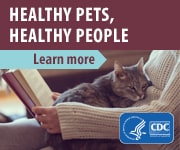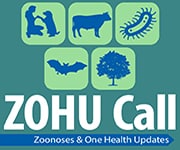September 2022 ZOHU Call
- Translocation of a Rabid Anteater Resulting in Multiple Human Exposures – Tennessee, 2021
- The projected expansion of coccidioidomycosis (Valley fever) endemic regions in response to climate change
- Integrating public health surveillance and environmental data to model the presence of Histoplasma
Date: Wednesday, September 7, 2022
Time: 2:00-3:00 pm (Eastern Time)
Web-on-Demand: A captioned video recording has been posted.
Course Access Code: ZOHUwebcast
Web-on-Demand: WD4565(SC)-090722
Origination Date: October 11, 2022
Expiration Date: October 11, 2024
Presentations:
One Health News from CDC
Casey Barton Behravesh, MS, DVM, DrPH, DACVPM
Captain, U.S. Public Health Service
Director, One Health Office
Centers for Disease Control and Prevention
dlx9@cdc.gov
Translocation of a Rabid Anteater Resulting in Multiple Human Exposures – Tennessee, 2021
Heather Grome, MD, MPH
Medical Officer, Epidemiology Research and Innovations Branch
Centers for Disease Control and Prevention
qds9@cdc.gov
The projected expansion of coccidioidomycosis (Valley fever) endemic regions in response to climate change
Morgan Gorris, PhD
Scientist
Los Alamos National Laboratory
mgorris@lanl.gov
Integrating public health surveillance and environmental data to model the presence of Histoplasma
Kimberly Kaufeld, PhD
Research Statistician
Los Alamos National Laboratory
kkaufeld@lanl.gov
Resources
Translocation of a Rabid Anteater Resulting in Multiple Human Exposures – Tennessee, 2021
The projected expansion of coccidioidomycosis (Valley fever) endemic regions in response to climate change
- Expansion of Coccidioidomycosis Endemic Regions in the United States in Response to Climate Change
- Economic Valuation of Coccidioidomycosis (Valley Fever) Projections in the United States in Response to Climate Change
- Coccidioidomycosis Dynamics in Relation to Climate in the Southwestern United States
Integrating public health surveillance and environmental data to model the presence of Histoplasma
Overall series objectives:
- Identify an implication for human, animal, and environmental health.
- Identify a One Health approach strategy for prevention of public health threats.
- Identify a One Health approach strategy for detection of public health threats.
- Identify a One Health approach strategy for responding to public health threats.
- List two ways to improve collaborative practice across the public healthcare team.
Disclosures:
In compliance with continuing education requirements, all presenters must disclose any financial or other associations with the manufacturers of commercial products, suppliers of commercial services, or commercial supporters as well as any use of unlabeled product(s) or product(s) under investigational use.
CDC, our planners, presenters, and their spouses/partners wish to disclose they have no financial interests or other relationships with the manufacturers of commercial products, suppliers of commercial services, or commercial supporters.
The planning committee reviewed content to ensure there is no bias.
The presentations will not include any discussion of the unlabeled use of a product or a product under investigational use.
CDC did not accept commercial support for this activity.

